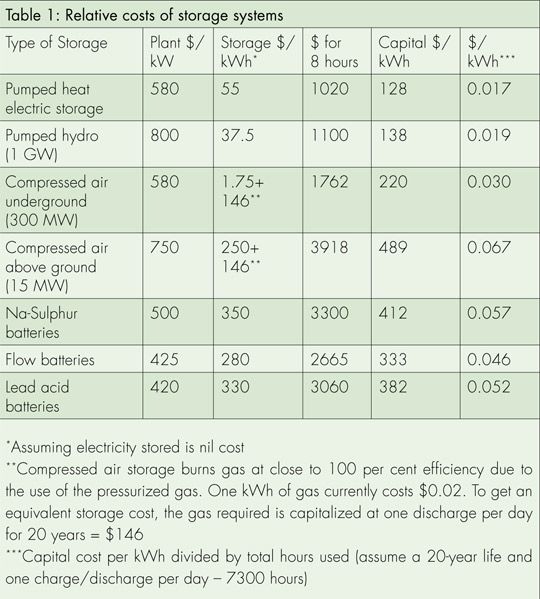It's almost cliche to claim that large-scale energy storage is the holy grail or missing link of renewable energy. (That will not stop me from using that bromide a bit longer, however.)
Today, the only economical method of storing energy at a large scale is pumped hydro (pumped hydro accounts for almost all large-scale electricity storage) or Compressed Air Energy Storage (CAES). Unfortunately, both of those technologies require easy access to an immense airtight underground cavern or a couple of large reservoirs.
I've quoted Haresh Kamath of EPRI's Technology Innovation Group as saying, "Storage is a great idea -- except for the cost." According to this EPRI spokesman, the technologies that are most likely to reach commercialization in the near term are Lithium-ion batteries and Compressed Air Energy Storage (CAES). Kamath expects the cost of large-format Lithium-ion (for electric vehicles and utility-scale storage) to drop to $250 per kilowatt-hour.
Jonathan Howes, the Chief Technical Officer of U.K. start-up Isentropic Energy, is out to prove otherwise. Howes is claiming large-scale storage costs that are an order of magnitude lower than Lithium-ion batteries or other stored energy technologies -- $55 per kilowatt-hour currently, with a path to get down to $8 per kilowatt-hour.
Isentropic's technology is compact, has no geographical constraints and claims a round-trip efficiency of 72 to 80 percent.
Pumped Heat Electricity Storage
Isentropic's Pumped Heat Electricity Storage (PHES) system is based on the First Ericcson cycle and uses a heat pump to store electricity in thermal form. The storage system uses two large containers of gravel, one hot (500C) and one cold (-150C). Electrical power is input to the machine which compresses/expands air to 500C on the hot side and -150C on the cold side. The air is passed through the two piles of gravel, where it gives up its heat/cold to the gravel. In order to regenerate the electricity, the cycle is reversed. The temperature difference is used to run the system as a heat engine.
The start-up claims that its reversible engine/heat-pump boasts three critical features:
- Very high round-trip efficiency -- 72 to 80 percent
- High reversibility -- the machine works as both an engine and heat pump. High reversibility means that if it first turns electricity into a temperature difference, it can then regenerate most of the electricity from the temperature difference.
- Gas cycle machine -- no use of damaging refrigerants, chemicals, or water
Isentropic's innovations include using aircraft engineering techniques to reduce piston weight and cost, designing new valving to eliminate pressure losses, and using a new sealing technology.
The design is intended for "small utility scale." Howes is targeting 2-megawatt 8-hour systems (16MW-hrs), although he claims that the systems can scale up and down. The firm is in the early stage and has built a "proof of ignorance prototype," followed by a technology demonstrator. Design of prototype three is now completed and has been built to demonstrate reliability.
Hopefully, this start-up can get the job done and we can finally retire that "energy storage as holy grail" cliche.

(Table from Isentropic Energy)



